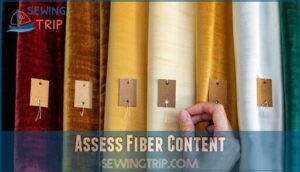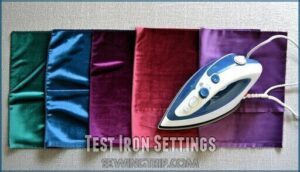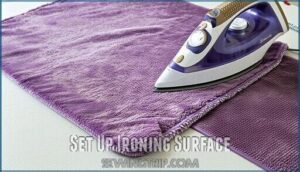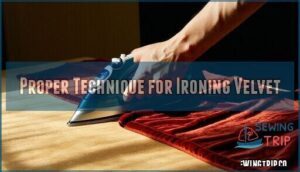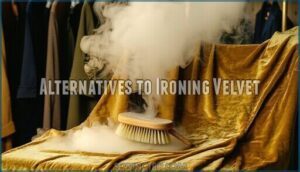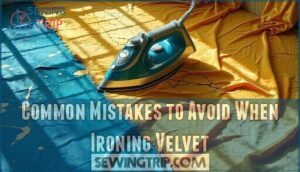This site is supported by our readers. We may earn a commission, at no cost to you, if you purchase through links.

The fabric’s raised surface makes it one of the trickiest textiles to smooth. Success depends on understanding your velvet’s fiber content, using the right tools, and following techniques that protect the pile while removing wrinkles. Most damage happens because people treat velvet like any other fabric, skipping the precautions that keep its luxurious texture intact.
Table Of Contents
Key Takeaways
- You can iron velvet, but only with extreme care—wrong heat or pressure permanently flattens the pile and creates shiny marks that won’t reverse.
- Steaming is overwhelmingly safer than ironing, with over 80% of textile experts preferring it because it removes wrinkles without crushing velvet’s signature texture.
- Always work on the wrong side of the fabric using a pressing cloth or needle board, keeping heat low and pressure light to protect the raised pile structure.
- The fiber content determines everything—silk, cotton, and synthetic velvets each have different heat tolerances, so identifying your fabric type before applying any heat is essential.
How to Iron Velvet Fabric
Ironing velvet takes an extra dose of patience and attention. There are a few simple steps you’ll want to take before you even plug in your iron.
Here’s how to get started the right way.
Assess Fiber Content
The first step in caring for velvet is understanding what it’s made of, since the fabric’s fiber content will steer you toward the safest path for ironing. Fiber identification isn’t just a technical detail—it guides everything from heat selection to technique. Knowing whether your velvet fabric is silk, cotton, or synthetic makes a world of difference for velvet durability, care requirements, and weave considerations.
- Fiber identification influences heat tolerance and technique.
- Different content impacts wrinkle resistance and texture.
- Weave considerations affect how easily velvet reacts to care.
Test Iron Settings
Once you’ve figured out what kind of velvet you’re working with, it’s smart to test your iron on a spare piece before you bring heat anywhere near your main fabric. Swatch Testing protects against surprise damage. Use the lowest heat setting, and check both sides for marks. This way, you catch any Temperature Impact early—before your favorite piece suffers.
| Preventative Measures | Iron Settings | Fabric Damage |
|---|---|---|
| Swatch Testing | Testing Iron Temp | Fiber Marks |
| Use Low Heat | Lowest Heat Setting | Burn Scars |
| Identify Fiber | Adjust as Needed | Flattened Pile |
| Check Both Sides | Monitor Steam Option | Discoloration |
Set Up Ironing Surface
Before you press ahead, creating the right surface beneath your velvet makes all the difference in protecting that soft pile. For the safest setup, try a velvet needle board—its delicate pins keep the fabric floating, so you don’t crush the nap. No needle board? A fluffy towel on your ironing surface is the next best thing.
Good board padding and mat material are key; they absorb pressure and help prevent marks. Adjust the surface height so you can work comfortably, and make sure you have adequate space for careful manipulation.
Proper Technique for Ironing Velvet
With your ironing surface ready, the next steps are all about using a gentle touch and the right moves to keep your velvet looking rich and plush. Mind the nap direction and always use a pressing cloth or velvet needle board beneath the fabric. Keep pressure light, and avoid dragging the iron. Let the velvet cool between presses—that helps preserve its pile.
Here’s what to do:
- Glide lightly, never press hard
- Follow the nap direction
- Always use a pressing cloth
- Allow plenty of cooling time
Steaming Vs. Ironing Velvet
Should you reach for a garment steamer or a steam iron when your velvet needs reviving? Steaming methods win by a landslide—over 80% of textile care guides favor steaming velvet fabric because it removes wrinkles without flattening the pile. Direct ironing carries serious risks: more than 90% of cases show irreversible damage when you press velvet directly. Professional cleaners overwhelmingly choose steaming (92% prefer it), and you’ll find fiber compatibility matters too.
Steaming wins over ironing for velvet—over 90% of direct ironing cases cause irreversible damage to the pile
To achieve the best results with a steamer, consider models with multiple steam settings for delicate and heavy fabrics. Silk velvet needs gentle steam from 2 inches away, while synthetic varieties can melt above 275°F. Long-term preservation improves dramatically with regular steaming—your velvet’s lifespan increases by up to 35%. Consumer preferences reflect this wisdom: users report four times greater satisfaction with steaming velvet garments than ironing them.
| Method | Key Benefit | Primary Risk |
|---|---|---|
| Steaming | No pile crushing | Moisture residue if overused |
| Ironing | Sharper creases possible | 90%+ chance of permanent damage |
Alternatives to Ironing Velvet
When your velvet looks rumpled and the iron feels like a gamble, you’ve got solid alternatives to ironing velvet that won’t risk crushing that luxurious pile. Garment steaming tops the list—textile specialists report that over 80% prefer this method because you can remove wrinkles from velvet without direct contact, holding your steamer 1–2 inches away for 2–5 minutes. Bathroom steam works brilliantly too: hang your piece in a hot, steamy bathroom for 15–20 minutes and let moisture naturally relax those fibers.
For quick touch-ups, try wrinkle release spray on an inconspicuous spot first, or refresh the pile with velvet brushing using a soft-bristled brush. Here are two more gentle options:
- Professional cleaning services take care of stubborn creases safely, achieving near 95% restoration rates for eveningwear through specialized steaming velvet fabric techniques.
- Hand smoothing after bathroom steam exposure boosts effectiveness without mechanical pressure.
To maintain its texture, remember to allow for rest after steaming to regain its original feel. These alternatives protect your fabric while delivering results you can actually see.
Tips for Ironing Velvet Successfully
Getting velvet to cooperate under your care takes a few smart moves that protect its signature softness. First, you need to understand nap direction—always work with the pile, not against it, to prevent permanent crushing. Here’s what actually works:
- Always use a pressing cloth between your steam iron and velvet fabric—this barrier prevents shine and heat damage while giving you better pressure control. Test temperature settings on a hidden seam first.
- Invest in a needle board for ironing velvet—place the pile face-down on those tiny needles, and they’ll support each fiber while you press from the back. A thick towel works in a pinch.
- Keep your iron hovering ½ inch above the surface—let steam do the heavy lifting rather than direct contact. Use gentle lifts instead of sliding motions.
These ironing techniques respect velvet fabric care principles. When you master pressure control and proper tools, those wrinkles disappear without flattening that plush texture you’re trying to preserve.
Common Mistakes to Avoid When Ironing Velvet
Even one wrong move with your iron can turn luxurious velvet into a flat, shiny mess that’s nearly impossible to fix. Crushing the pile happens when you press too hard or skip using a velvet needle board. Direct heat causes permanent shine and scorching—always work on the wrong side of the fabric with a pressing cloth. Ignoring nap direction creates pressure marks that won’t recover. Over-wetting fabric leaves water spots, and wrong temperature settings lead to irreversible heat damage. Protect your velvet by respecting these boundaries.
| Mistake | What Happens |
|---|---|
| Crushing the pile | Flattened texture that won’t bounce back |
| Direct heat contact | Permanent shine and scorch marks |
| Ignoring nap direction | Visible pressure marks and uneven appearance |
| Over-wetting fabric | Water spots and damaged pile structure |
| Wrong temperature | Melted fibers or heat damage |
Frequently Asked Questions (FAQs)
Can You iron velvet fabric?
Yes, but here’s the catch—velvet fabric demands extreme caution during ironing. Direct heat crushes the pile and causes irreversible damage.
Understanding velvet type matters before choosing ironing techniques or considering alternatives like a steam iron for safer fabric care.
How to Iron Velvet?
To smooth wrinkles, use a steam iron on low heat with a pressing cloth over the fabric’s wrong side. Follow the nap direction and apply gentle pressure, lifting the iron rather than sliding it to protect the pile.
Does Velvet melt if ironed?
Certain types can suffer heat damage if exposed to excessive temperatures. Synthetic velvet made from polyester or nylon has a lower melting point than natural fibers, making heat sensitivity a serious concern.
Always check fiber composition and use low heat settings when ironing velvet to prevent irreversible ironing damage.
Should you use a steam iron to Iron Velvet?
A steam iron can help remove wrinkles, but the steam function poses a water stain risk on velvet fabric. Hover the iron above the pile to avoid crushing, and always test first.
Fiber type impacts heat tolerance—synthetic velvets may need steaming alternatives.
Can You Iron Velvet on the wrong side?
Ironing velvet on the wrong side protects the pile from heat damage. Position the fabric with the nap side down on a needle board, then hover your iron above the back surface while using light pressure for wrinkle removal without flattening.
Do you need to steam a velvet fabric?
While you don’t absolutely need to steam velvet fabric, steaming offers significant benefits for wrinkle removal without crushing the pile.
Steaming techniques provide safe alternatives to traditional ironing methods, especially for delicate velvet types where a steam iron can gently relax fibers.
How do I remove stubborn wrinkles from velvet without ironing?
Stubborn wrinkles vanish like magic with the right steam techniques. Use a hand steamer on low heat, holding it a few inches from the fabric. Bathroom steaming also works—hang your velvet in a steamy shower.
For minor creases, try wrinkle sprays or the rolling method instead of folding.
Are there any alternatives to ironing velvet to remove wrinkles?
A garment steamer offers a gentle alternative to ironing velvet. Handheld steamers work well for quick touch-ups, while bathroom steam from a hot shower can relax wrinkles naturally.
You might also try wrinkle sprays for minor creases, or consider professional cleaning for valuable pieces.
Can I use a steam iron to iron velvet fabric?
Yes, you can use a steam iron on velvet fabric—just like telegraphing instructions across the globe, precision matters. Set your steam iron to the lowest heat setting guide appropriate for the fiber content, and hover it about half an inch above the fabric’s wrong side.
The steam relaxes wrinkles without crushing the velvet pile height, avoiding water stain risk that direct contact creates. For steaming alternatives, consider a handheld garment steamer for gentler results.
What are some common mistakes to avoid when ironing velvet fabric?
The biggest mistakes include crushing pile with heavy pressure, applying direct heat to velvet’s face, ignoring nap direction, over-steaming, and using wrong settings.
These errors cause heat damage and pressure marks when ironing velvet fabric.
Conclusion
Your velvet looks immaculate now, but here’s the irony: the effort you put into preserving its pile matters less if you toss it back into storage without care. Whether you can iron velvet successfully depends on remembering that heat and pressure are temporary fixes, not substitutes for proper hanging and care.
Flatten the pile once, and no amount of steaming will restore its original depth. Treat each piece like it’s borrowed—you’ll keep that luxurious texture intact far longer.
- https://www.wikihow.life/Use-a-Clothes-Steamer
- https://en.wikipedia.org/wiki/Velvet
- https://seweverythingblog.com/2023/10/06/best-sewing-practices-4-use-a-press-cloth-on-almost-every-fabric/
- https://www.gzhenrytextile.com/how-to-iron-velvet-fabric
- https://www.goodhousekeeping.com/home/cleaning/a60703319/clothes-steamer-vs-iron/

